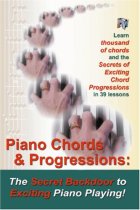Complex Chords For Piano
Complex Piano Chords
| Good morning. This is Duane and today we’re going to take a look at complex piano chords. We’ve covered all the basic kinds of chords. We’ve covered major, minor, diminished, augmented, sixth, seventh, major sevenths, minor sevenths and ninths and elevenths and thirteenth chords on various videos that we’ve done over the last few months. Today I’d like to cover the complex chords. You often run into them in jazz particularly where notes are altered and it’s hard to figure out sometimes what the chord is. Let’s take a look at that.
|
| A complex chord first of all is something that’s been altered. It’s not a standard ninth. That would be a standard ninth. That would be a standard major ninth. Let’s say that we have a standard ninth but I flat the fifth. That’s a complex chord. Say I instead of playing the ninth, I play the flat ninth. Instead of playing the normal eleventh, I play a raised eleventh. That’s a complex chord. Anytime you alter a chord you run into that. Let’s take a look at some of the most common complex chords.
|
| First of all you can use a flat fifth with lots and lots of chords particularly if you’re talking about sevenths or ninths or elevenths or thirteenths. You can flat the fifth of the chord. Let’s say that we have a C thirteenth. If we leave the eleventh out and flat the fifth, we have that chord. Sometimes that can be used as a passing tone like this. Hear that? It gives a little nuance, a little nuance to the chord. A flat fifth is a possibility and so is a flat ninth.
|
| That’s a chord that’s very, very pregnant. It wants to move on to the next chord very badly till it resolves. Another alteration would be the same as a raised eleventh. It would be a flat five but we’ll call it a sharp eleventh. That’s basically all the alterations. Now you can combine color tones. In other words, we can not only have a C six but we can have a C six, major ninth. Play it like that, third, fifth, sixth and ninth. That’s a frequent sound that we get. Just move up by a half step and you’ve got the D flat chord.
|
| Now I use several complex chords. Notice there. I use A flat seventh chord over a low G. That’s a flat ninth there. When we get home we can put, say if you can get a ninth or a second into the final tonic chord. I just wanted you to know that the complex chords are a combination of either altering one or more notes or combining one or more color tones or any combination thereof. For example, I could be playing a C seventh in my left hand and put a sixth in my right hand and a flat ninth like that.
|
| Okay, that’s it for today. If you enjoy these kind of piano tips, come over to PlayPiano.com and sign up for the whole series of tips. They’re all free. Hope to see you there. Bye-bye for now.
Click on this link to watch this video on YouTube: https://www.youtube.com/watch?v=IaN5CZnSFLQ ***For lots more good stuff on piano playing come on over to my website at https://www.playpiano.com and sign up for our free piano tips – “Exciting Piano Chords & Sizzling Chord Progressions!” Here’s a great little book on chords and chord progressions on Amazon: http://www.amazon.com/Piano-Chords-Chord-Progressions-Exciting-ebook/dp/B0076OUGDE/ref=sr_1_1?s=books&ie=UTF8&qid=1404158669&sr=1-1&keywords=piano+chords+duane+shinn
|




